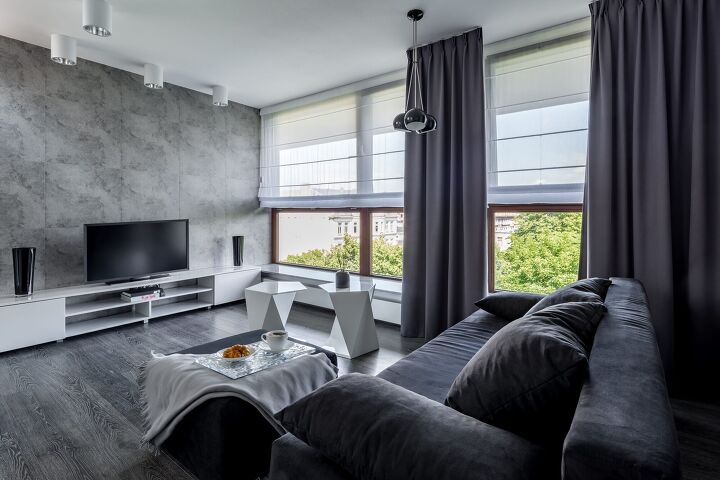How To Make Windows Private

There is nothing more uncomfortable than getting ready to sit down and watch your favorite show after a long day’s work, only to look out the window and see some person standing there, making eye contact with you.
It’s creepy, and it’s not something you look forward to; it’s time to make your window private! But how do you do that?
To make your windows private, add some blackout curtains or window shades. There are also a variety of different window films or glass replacements that allow it so that no one can see in your window, although, some of these choices don’t allow you to see out.
Below we will take you through the different options to make your windows private. This will allow you to be more comfortable at home when you’re relaxing in your living room.
Let’s see what the options are!
How Do You Make Your Windows Private?
It is possible to make your windows hidden at night in a variety of ways. Here are a handful; let’s look at them.
Window Blinds
Blinds are a clear selection when it comes to window privacy, and there are many different kinds available. One of the most prevalent and well-liked solutions, for instance, is the use of horizontal or Venetian blinds, which are available in a range of materials, such as wood, vinyl, faux wood, or plastic.
Vertical blinds are one of the other varieties of blinds and are frequently used to cover glass entrances. Even blinds that are already installed in the window itself are an option; commonly, these are Venetian blinds.
You can either buy a kit that goes over your current window or, in some situations, a window that already has the blinds built in.
These blinds are practical since they offer seclusion, require no dusting, and cannot entangle children or pets.
Blackout Curtains
Blackout curtains offer the best amount of privacy. These types of curtains fully block out the light.
The people outside the window are unable to observe what is happening inside as a result. Because of this, these drapes are sometimes referred to as privacy curtains.
Blackout curtains come in a variety of sizes and hues. The blackout curtains can filter out noise from outside the window in addition to blocking out light.
However, there is a drawback to these curtains as well. They have the ability to turn the room completely dark, which some people don’t like.
What Kind Of Film Can You Use To Make Your Windows Private?
There are many different types of window film that can offer you some privacy. Below are the best options to choose from that can help keep your windows private in the day and night.
Window Film You Can Dim
A changeable window film has quickly become popular throughout the entire world. It distinguishes itself from other window films due to its outstanding qualities.
With these window films, you not only receive security and privacy but also shading and heat insulation. Additionally, an electrically controlled switch can be used to modify the light transmission.
Perforated Window Film
Perforated window film is a term that not many people are familiar with; a perforated window film is an impenetrable window film for those of you who are unaware.
These window films are dazzling from the outside while being black on the inside. They have holes in them and are tightly packed.
With the aid of these apertures, light can enter the space. As a result, it gives the appearance of a white window that allows you to look outside.
Blackout Window Film
The blackout window tint is the ideal choice for you if you need complete privacy in your bedroom. You will always have complete privacy all day, day or night.
It is a style of ornamental film that fully obstructs the entry of light into the space. As a result, it also makes it impossible for you to see outside the room.
If you frequently wish to look outside your window, this window film is not for you.
Decorative Window Film
A decorative pattern can be added to your window to increase privacy in your space. You will have all the privacy you require in addition to enhancing the room’s beauty.
Compared to reflecting window films, these window films are somewhat different. Reflective window films lack patterns or designs in contrast to decorative window films. All they have is a tinge.
This is why a decorative window film is a well-liked option when it comes to tinting shower or bathroom doors.
Reflective Window Film
One of the most prevalent window films available is a reflective window film. On the other hand, there is a very good likelihood that this window film won’t function at night.
The reason for this is that a reflective window coating uses external light and sunlight to function. It renders these shades translucent as a result.
It must be brighter outside the room than in the room you need privacy in for them to function correctly. Because of this, there is a very good likelihood that they won’t perform as well as other window films at night.
Privacy Window Films
Blackout drapes and blinds are declining in popularity as privacy window coatings become more widely available. What makes these privacy window films different from others?
With these privacy window films, the utmost amount of privacy is possible. You can utilize a variety of window films, including opaque, opaque frosted, and dimmable window films.
Using window film of any kind will provide you with the greatest amount of seclusion. Blackout curtains and blinds have been replaced by window films for this reason.
What Type Of Glass Makes Your Window Private?
If you are not into the curtains and you don’t want window film, you can replace the entire glass of your window instead. There are different types of glass that will make your window private, which we have listed for you below.
Glass Bricks
Glass bricks are frosted glass blocks that, like masonry bricks, can be used to build barriers, screens, and privacy walls. Glass brick panels provide good visibility, preserving natural light while granting privacy on the opposite side.
You may add privacy where you need it in your house or apartment quickly and easily by using glass bricks to make walls and screens without sacrificing natural light.
There are two varieties of glass bricks: clear and textured.
To provide seclusion and divide the cooking area from an eating/lounge area while preserving a visual link with the rest of the space, clear glass brick panels are frequently utilized behind a kitchen counter.
Bricks with texture can be glazed (which increases light diffusion) or have designs carved into them (e.g., a wave pattern). These are frequently used in bathrooms and laundry rooms to provide privacy while allowing light or views out the window adjacent to it.
Their appearance and texture also give visual appeal.
Textured Glass
One of the most widely used glass materials for privacy is textured glass.
It is made by holding a piece of transparent or colored glass up to a patterned mask, which is then blasted with sand (or another material) at high speed to leave an imprint on the surface.
Any pattern can be used to create textured glass, but the most popular (and easiest) is a repetitive grid or chevron pattern.
This glass is available in clear, tinted, or reflective coatings and can be up to 40mm thick.
The benefit of textured glass is that it allows you to see out clearly while preventing anyone from being able to see in. You can see out, but you can’t see specifics of what is on the other side.
Since privacy is crucial, it is a popular glass option for living rooms, bedrooms, and home offices (e.g., if you have work done in your house or apartment).
Additionally, this works well for companies who want to offer some level of privacy without muzzling sound or light.
The strength and degree of privacy of textured glass might vary depending on its thickness and quality.
If someone tries to look through it or break the glass, they won’t be able to see it as clearly because the glass is stronger the thicker it is (for example, up to 40mm).
Smaller locations that you do not want anyone peeking into but still need some light and perspectives from other parts of your house or apartment are better suited for thinner (for example, 20mm) textured glass.
Smoked Glass
Another option for enhancing privacy is smoked glass.
You can see through it, but it’s like peering into the fog because the clear glass has been coated with a tiny layer of metallic oxide, which provides an opaque effect and shuts out images from the other side.
Smoked glass screens are typically between 20 and 25 mm thick, with metallic or non-metallic oxide layers and reflective or non-reflective finishes.
This choice has the benefit of letting you see outside and providing a reflected appearance if you wish it, but it is also sufficiently substantial that when someone looks in, they will only be able to see your shadow or silhouette.
This makes it a great option for bathrooms, smaller rooms where you want a little bit more seclusion, living rooms with big windows (like French-style doors), and bedrooms.
Smoked glass is less porous than textured or frosted glass; thus, if left untreated, it won’t accumulate watermarks.
It can also be washed using the same tools as standard clear/reflective glass, such as a squeegee and window cleaner.
Colored Glass
Crystal clear glass that has a coating added to it modifies the way light travels through it by either soaking up or reflecting colors. This is known as colored glass.
Green glass, also known as “Avonite,” is the most popular hue because of its high level of privacy and capacity to block out nearly all-natural light, making it ideal for spaces where you don’t want people looking in but still need to be able to see out.
Colored glass typically measures 20mm thick and is available in a variety of finishes, including clear (for ultimate privacy) and tinted with dark or light tints depending on the degree of privacy you seek.
A UV-resistant layer that prevents the colored glass from fading from exposure to sunshine, as can happen with untreated windows, is also available with pre-coated on colored glass.
A glass window’s tinted film not only acts as a point of attraction but also as a dramatic focal point, casting a variety of colored light onto the surfaces in the manner of a contemporary stained-glass window.
Related Guides:

Heather is a passionate writer who loves anything DIY. Growing up, she learned everything from home repairs to design, and wants to share her tips with you. When she's not writing, she's usually hiking or searching for her next DIY project.
More by Heather Robbins











![Finishing Basement Without Permit [Is It Really Illegal?]](https://cdn-fastly.upgradedhome.com/media/2023/07/31/9070078/finishing-basement-without-permit-is-it-really-illegal.jpg?size=350x220)















